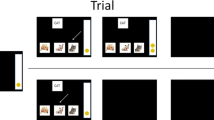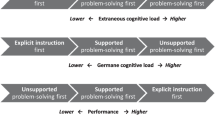Abstract
An investigation was made of the effects of amount of guidance, sequence of instruction, and attribute-treatment interactions on speed of learning, retention, and transfer of ten intellectual skills that form part of a learning hiererchy and which are commonly part of secondary school physics courses. Four clearly-defined instructional methods were used; the methods form a linear scale from least to most guidance. It was found that the numbers of errors made in reaching a criterion performance on the skills decreased as the amount of guidance was increased, but transfer and retention were unaffected. Two sequence styles were used, which were both consistent with the requirement that no skill should be taught before the skills that were subordinate to it in the learning hierarchy. Form of sequence had no effect on speed of learning, retention, or transfer, and there was no interaction between sequence and amount of guidance. A novel method was employed to search for the presence of any interaction between attributes of learners and the amount of guidance. None was found. It is concluded that a maximum of guidance can be used to teach intellectual skills to all learners with no negative effect on retention and transfer. It is suggested that variables other than amount of guidance or sequence are more likely to affect a learner's retention or transfer of a skill. Finally, patterns of retention of skills that are connected in the learning hierarchy were found to be contrary to an earlier result. The patterns suggest that a skill in a learning hierarchy cannot be recalled unless its relevant subordinate skills are also recalled.
Similar content being viewed by others
References
Ausubel D. P. (1968). Educational Psychology: A Cognitive View. New York: Holt, Rinehart & Winston.
Brown J. L. (1970). “Effects of Logical and Scrambled Sequences in Mathematical Materials on Learning with Programmed Instruction Materials.” Journal of Educational Psychology 61, 41–45.
Bruner J. S. (1961). “The Act of Discovery.” Harvard Educational Review 31, 21–32.
Corman, B. R. (1957). “The Effect of Varying Amounts and Kinds of Information as Guidance in Problem Solving.” Psychological Monographs 71 (2, Whole Number 431).
Cronbach L. J. (1967). “How Can Instruction be Adapted to Individual Differences?” In Learning and Individual Differences, R. M. Gagné (Ed.). Columbus: Merrill.
Gagné R. M. (1972). “Domains of Learning.” Interchange. 3, 1–8.
Gagné R. M. and Bassler O. C. (1963). “Study of Retention of Some Topics of Elementary Non-metric Geometry.” Journal of Educational Psychology. 54, 123–131.
Gagné R. M. and Staff, University of Maryland Mathematics Project. (1965). “Some Factors in Learning Non-metric Geometry.” Monographs of Society for Research in Child Development, 30, 42–49.
Hermann G. (1969). “Learning by Discovery: A Critical Review of Studies.” Journal of Experimental Education. 38, 58–72.
Kersh B. Y. (1962). “The Motivating Effect of Learning by Directed Discovery.” Journal of Educational Psychology. 53, 65–71.
Levin G. R. and Baker B. L. (1963). “Item Scrambling in a Self-instructional Program.” Journal of Educational Psychology. 54, 138–143.
Meconi L. J. (1967). “Concept Learning and Retention in Mathematics.” Journal of Experimental Education. 36, 51–57.
Niedermeyer F. Brown J. and Sulzen B. (1969). “Learning and Varying Sequences of Ninth-grade Mathematics Materials.” Journal of Experimental Education. 37, 61–66.
Payne D. A., Krathwohl D. R. and Gordon J. (1967). “The Effect of Sequence on Programmed Instruction.” American Educational Research Journal. 4, 125–132.
Roe K. V., Case H. W. and Roe A. (1962). “Scrambled Versus Ordered Sequence in Autoinstructional Programs.” Journal of Educational Psychology. 53, 101–104.
Scheffé H. (1959) The Analysis of Variance. New York: Wiley.
Tallmadge G. K., Shearer J. W. and Greenberg A. M. (1968). “Study of Training Equipment and Individual Differences: The Effects of Subject Matter Variables.” American Institutes for Research in the Behavioral Sciences, Palo Alto: Technical Report NAVTRADEVCEN 67-C-0114–1.
White R. T. (1973) “Research into Learning Hierarchies.” Review of Educational Research. 43, 361–375.
White R. T. (1974). “The Validation of a Learning Hierarchy.” American Educational Research Journal 11: 121–136.
Worthen, B. R. (1968). “Discovery and Expository Task Presentation in Elementary Mathematics.” Journal of Educational Psychology. 59. Monograph Supplement 1–13.
Author information
Authors and Affiliations
Rights and permissions
About this article
Cite this article
White, R.T. Effects of guidance, sequence, and attribute-treatment interactions on learning, retention, and transfer of hierarchically ordered skills. Instr Sci 5, 133–152 (1976). https://doi.org/10.1007/BF00052420
Issue Date:
DOI: https://doi.org/10.1007/BF00052420




